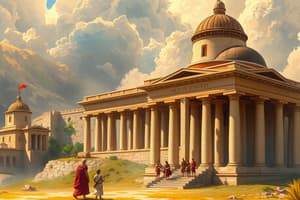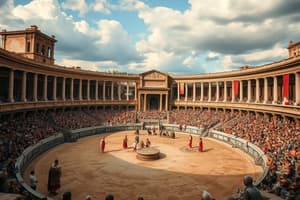Podcast
Questions and Answers
What was the primary social distinction between commoners and aristocrats in Europe?
What was the primary social distinction between commoners and aristocrats in Europe?
- Commoners had political power and land ownership.
- Aristocrats held most of the land and military power. (correct)
- Commoners were only part of the Church.
- Commoners were typically wealthy merchants and traders.
Which statement best describes the Church's structure after the fall of the empire?
Which statement best describes the Church's structure after the fall of the empire?
- The Church modeled its structure after that of the old Roman government. (correct)
- The Church had no defined leadership after Emperor Constantine.
- The Church operated independently without any major organizational structure.
- The Church dissolved and lost its influence in Europe.
Who was considered the leader of the Church throughout the world?
Who was considered the leader of the Church throughout the world?
- The archbishop of Nicaea.
- The pope. (correct)
- The emperor of Rome.
- Theodosius I.
What major change did Emperor Theodosius I implement regarding religion in the Roman Empire?
What major change did Emperor Theodosius I implement regarding religion in the Roman Empire?
Which group was NOT included among the commoners in Europe?
Which group was NOT included among the commoners in Europe?
What significant event marks the beginning of the Great Fall of the Western Roman Empire?
What significant event marks the beginning of the Great Fall of the Western Roman Empire?
What was a common aspect of life for the majority of people in the Western Roman Empire before its collapse?
What was a common aspect of life for the majority of people in the Western Roman Empire before its collapse?
What role did patriarchy play in the social structure of the Roman Empire?
What role did patriarchy play in the social structure of the Roman Empire?
Which of the following groups did NOT play a significant role in shaping life during the Middle Ages in Europe after the fall of the Roman Empire?
Which of the following groups did NOT play a significant role in shaping life during the Middle Ages in Europe after the fall of the Roman Empire?
How did the fall of the Western Roman Empire affect daily life for many people living far from Rome?
How did the fall of the Western Roman Empire affect daily life for many people living far from Rome?
Study Notes
The Fall of the Western Roman Empire
- Timeline: The Western Roman Empire faced turmoil beginning in the 300s CE and ultimately fell in 476 CE due to invasions by Germanic tribes.
- Extent: At its peak, the Roman Empire spanned Europe, northern Africa, and parts of Asia.
Social Structure in the Roman Empire
- Political Class: Members enjoyed luxurious lives with large homes, parties, and service from enslaved persons; participated in civic gatherings.
- Common Citizens: Most lived modestly, with lower classes residing in simple homes and working hard, often watching chariot races and gladiator fights during their leisure.
- Patriarchy: A male-dominated system where the oldest man held decision-making power; women took care of the home and children, possessing limited rights.
Life After the Fall
- Continuity: Post-fall, daily life continued similarly for many, especially those living far from Rome, who may not have been aware of the empire's decline.
- Language and Society: Despite the fall of governance, the structure and language evolved slowly over the subsequent years.
The Middle Ages
- Timeframe: The period following the fall of the Western Roman Empire is known as the Middle Ages or medieval period.
Influential Groups in Medieval Europe
- The Church: Comprised of clergy (bishops, monks, priests) and became the most significant institution post-Rome's fall.
- Aristocracy: Wealthy landowners held the majority of land and political/military power, often passed down through families.
- Commoners: Included everyone not in the aristocracy or Church, ranging from wealthy merchants to the poor; craftspersons and bankers formed the middle class.
Establishment of Christianity
- Emperor Constantine's Influence: Promoted Christianity, which gained official status under Emperor Theodosius I in 380 CE, establishing it as the Roman Empire's official religion.
- Church Organization: Modeled after the Roman government, the Church had regional headquarters in major cities, with the pope as the leader of Catholicism globally.
Studying That Suits You
Use AI to generate personalized quizzes and flashcards to suit your learning preferences.
Description
Explore the significant factors leading to the fall of the Western Roman Empire in 476 CE. This quiz covers invasions by Germanic tribes and contrasts the lifestyles of the political elite with those of the lower classes. Dive into this tumultuous era of history and test your knowledge on one of the most pivotal moments in European history.





